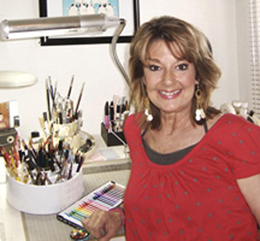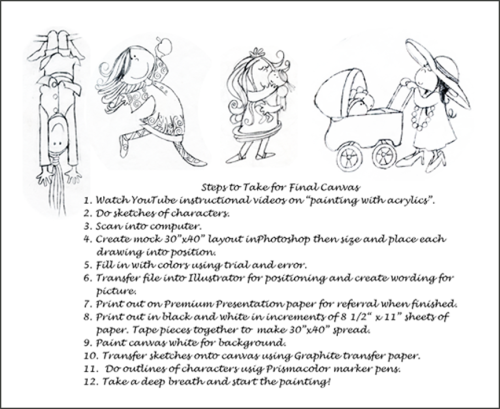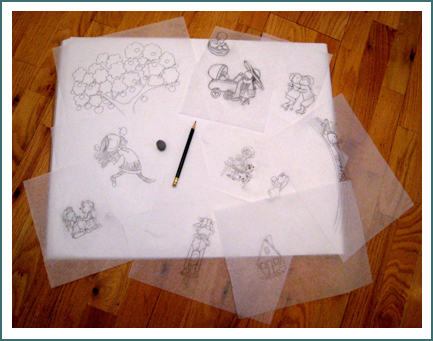 Our featured illustrator this week is Susan Drawbaugh. She loves to draw and do whimsical illustrations. Early in her art career she was greatly influenced by a man she met while touring the MGM Animation Studios, Ben Washam. As one of the original animators of the Bugs Bunny, Road Runner, and Tom & Jerry cartoons, he ended up passing down the skills of his trade by teaching a small group of aspiring animators from his home. Susan was one of those fortunate students.
Our featured illustrator this week is Susan Drawbaugh. She loves to draw and do whimsical illustrations. Early in her art career she was greatly influenced by a man she met while touring the MGM Animation Studios, Ben Washam. As one of the original animators of the Bugs Bunny, Road Runner, and Tom & Jerry cartoons, he ended up passing down the skills of his trade by teaching a small group of aspiring animators from his home. Susan was one of those fortunate students.
Although she never made a career of animation, years later she wrote and illustrated her first children’s book, What Pet Will I Get?, an animated “Flip n Giggle” picture book that was soon published. A mix of creative ventures followed, until she made the decision to become a freelance commercial illustrator.
Her range of work spans from children’s picture books, stationery lines, canvas paintings, infant bedding, and editorial picture puzzles – to humorous wall prints, greeting cards, coffee mug lines, holiday decor, and chapter illustrations. Susan uses the traditional method of illustrating by hand, but throughout the course of every project she puts her digital skills to work, as well.
Surrounded by the coastal charm of Southern California, she creates from my home studio by the port of San Pedro. Take a look. I am sure it will put a smile on your face.
Here’s Susan explaining her process:



6) The next step was to transfer the drawing onto my canvas. This was done by placing the canvas on the floor, and taping sheets of graphite transfer paper face down between the canvas and the illustrated print out.




9) First I started with the tree – then each of the characters.





10) Next, the writing of the verse. After I delicately painted the entire verse of Say, Say My Playmate in place, I realized that it didn’t do the painting justice – it was just too busy! I ended up removing all but the main line over the rainbow.

Once I finished my grandbaby Laney’s painting, Say, Say My Playmate, I strategically added glitter here and there to it. WOW!! What a difference it made! To avoid it looking tacky, I was careful not to overdue it, so I just filled in a few select apples, part of the buggy wheels, and a spot on some of the characters’ shoes or hair decor. It doesn’t show up in this photo nearly as dramatically as it looks in person, but take my word for it it’s eye-catching, and sparkles even with just a tidbit of light on in the room.

1. When did you start painting?
Knowing how much I’d always loved to draw, my parents bought me an oil paints set and easel for Christmas when I was 11.

2. Did you go to school for art?
I had an excellent high school art teacher, won a summer scholarship to take classes at the Chicago Art Institute when I was 14, and majored in commercial art in Jr. College. When I was 22 I was part of a small animation class taught by an animator from Warner Bros. who worked with Chuck Jones from the beginning of the old Tom & Jerry and Road Runner cartoons. He built me a light board, and held classes in his home free of charge as his way of passing the skills of his trade down to aspiring young animators. I was interviewed by Chuck Jones, who hired me to work at MGM Animation Studios, but soon thereafter it folded, so that job didn’t come to fruition.

3. What was the first thing you did and got paid for?
Wow…. that’s taking me back! My first paying job was doing a cartoon illustration of a dog in his dog house for the local newspaper, Palos Verdes News.

4. Do you have a favorite material? Watercolor, acrylic, oil, etc.
I’ve done a few projects using watercolors, but almost always do my illustration work using pen & ink and markers, followed by Prismacolor pencils for the shading. I have to say that I’ve come to love acrylic paint on canvas for my wall art since doing a painting for my grandbaby’s room. At first it was very intimidating since it dries so fast, but I learned how to use it for my particular style by trial and error.


5. Has you material or style changed over the years?
I’ve changed the look of my characters to be less commercially cartoony by minimizing the big eyes and cartoony body proportions and details to being a bit more realistic.


6. I noticed you had a large number of colored markers in your studio. When and how do you use them?
After doing my final pencil illustration on bleedproof illustration paper, I go over it with a fine point pen, and fill in the colors with the markers – using slightly lighter colors of the color palette that I have in mind so that I can emphasize the contrast of the shading.

7. Did you spray anything over the glitter that you applied at the end to help keep it in tack?
It wasn’t necessary. The glitter was added by putting a fairly thick coat of permanent fabric glue on top of each apple, and pouring the glitter onto it. Once it was completely dry I tipped the canvas and tapped it until all of the excess glitter was off.

8. Do you use Photoshop in any of your illustrations?
When and where do you use Photoshop? Once I’m finished with the hand work of the illustration, I scan it into Photoshop at 360 dpi and use the paintbrush tool for backgrounds and fine-tuning. If there’s lettering in the illustration I find a font that works and use that, as well.


9. Have you ever used a graphic tablet? Do you plan to try one in the future?
I’ve always used a graphic tablet when working in Photoshop. The mouse that comes with it doesn’t feel comfortable to me, so I use the tablet pen.
 10. You say you met a man at MGM who influenced your art when you took a course on animation. What were you doing before that time?
10. You say you met a man at MGM who influenced your art when you took a course on animation. What were you doing before that time?
I was working as a Production Supervisor and Paste-up Artist for the advertising dept. of J.C. Penney Co.


11. Did studying with him, change your illustrating style?
He was a huge influence on my putting personality and action into my characters.

12. How did you end up being represented by Christina Tugeau? How long have you been with Chris?
I “met” Chris when she was working for another children’s book agent back in 1991. I had written and illustrated a children’s book, and talked with her frequently on the phone concerning representation. I ended up deciding to self publish (then later got cold feet). Meanwhile, Chris and I kept in touch on and off through the years after she started her own company. She was very generous with her advice – a wonderful, kind and dedicated woman! Eventually, I put my art career on hold to focus on a couple of baby products that my older daughter and I invented. A few years later, when I decided to give my full attention to illustration work, I sent my blogs to Chris where she saw new work that I’d done. Much to my surprise, she soon sent me an email offering me a contract. That was in November of 2011.

13. How many picture books have you illustrated?
Eight

14. How did you get that first picture book contract?
After getting a rejection from Random House, I took my prototype to the owner of a bookstore here in San Pedro for advice, and was told about Morgan Press, a publisher in Palos Verdes. I called Lora Morgan and, with curlers in my hair because she said she was about to leave, tore off to her office and handed her my prototype (consisting of all my originals!) as she was just pulling out of her driveway! A week later I got a call from her offering me a contract.

15. It looks like you are writing and illustrating your own books? Is writing a challenge for you or is that been something you have always done?
All but one of my books was written in lyrics, and writing poetry is something I’ve done all my life. The biggest challenge came when trying to come up with words and phrases that fit for a child. I once went through my entire dictionary and made lists of descriptive words and verbs. Through the years I’ve collected my favorite children’s picture books, which I often refer to for writing and illustrating techniques.

16. Do you illustrate the note cards and sell them on your own or does a card company own them?
I was hired by Stuart Hall Inc, once the major manufacturer and distributor of school notebooks and paper products, as a freelance illustrator for their Juvenile stationery lines. They sold the products to Walmart and other mass market stores. They’ve since sold the company to Newers, so I haven’t been involved with them in quite awhile.

17. Since you have a studio in your house, do you have problems getting people to realize you are working and not to bother you?
Great question!! I definitely used to – especially when my two daughters lived at home! I’ve pretty much had to “train” my family and friends to respect this as my career. My husband has been wonderful about giving me my space!

18. What are you working on now?
I’m working on finishing a prototype for a picture book that I started a few years ago, Pickles & the Poof!



19. Are there any marketing things you do that help you get additional work?
My website and blog to be sure! I recently joined SCBWI, and attended a Portfolio Review last October. In August I’m going to their 2012 L.A.Summer Conference in August. I also joined Illustration Friday and, when time allows, I submit illustrations there. In the past the most productive method for me has been sending out brochures showing samples of my work to commecial companies appropriate for my illustration style. …. And of course, putting together material for Chris to send to her list of children’s book editors.

20. Do you have any words of wisdom for your fellow illustrators that might help them become more successful?
I have two bold lettered quotes taped to my studio wall. One says, “Pursue excellence, ignore success.” …. Which I’m thinking means that if you attain excellence success will follow. The other says, “Stop at Nothing”. I made that one up to inspire me to continue to do research on anything pertaining to my field, practice my illustration skills, and be persistent in achieving my goals. So far, persistence has paid off for me in many of my endeavors.
Thank you Susan for sharing your illustrations and the art you did for your grandchild. I can really see that it was painted with so much love. We look forward to seeing more of your illustrations in future picture books.
You can visit Susan at: www.susandrawbaugh.com I am sure Susan would love if you left a comment here about her artwork if you a have minute.
Talk soon,
Kathy

I love the bright bold look of your illustrations! Thanks for sharing your work with us. You have the perfect name for an artist, too. Easy for those art directors and editors to remember!
LikeLike
By: wendy on May 5, 2012
at 9:39 am
Thanks so much, Wendy :o). I know…. my last name is quite a coincidence!
LikeLike
By: susandrawbaugh on May 5, 2012
at 11:09 am
I love your composition and I am so pleased to be able to read about your techniques with photoshop, etc. Thank you for sharing.
LikeLike
By: Jane Fritz on May 5, 2012
at 10:09 pm
I’m so glad you enjoyed the interview, Jane. … Thank you for taking the time to comment :o).
LikeLike
By: susandrawbaugh on May 6, 2012
at 8:53 pm
fun to see the progression of images and all Susan… and the fun colors and development of the humorous way you see life. Glad to have you abourd!
LikeLike
By: catugeau on May 6, 2012
at 11:43 am
Thank you, Chris :o). And as you already know, I’m happy to be abourd…. abored…. aboard!
LikeLike
By: susandrawbaugh on May 6, 2012
at 8:54 pm
that is ABOARD!!!! jeeeez 🙂
LikeLike
By: catugeau on May 6, 2012
at 11:44 am